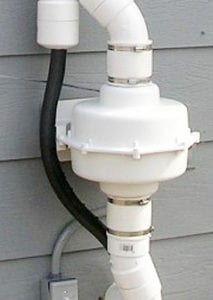ADU-500 Offers Cost-Effective, Wireless Solutions to Contractors
Radon is a colorless, odorless radioactive gas that is present in trace amounts in the environment. It results as part of the radioactive decay chain of uranium and thorium in the earth’s crust. The problem is that it can leak up from the ground and accumulate in buildings; there is clear evidence that breathing air with high concentrations of radon gas can cause lung cancer. It is highly recommended that, in areas that are known to have elevated Radon levels in the soil, any homes be tested for internal Radon levels. In the US, the EPA recommends that corrective action be taken if the level in the air is found to be above 4 picocuries per liter (pCi/L). The most common solution is to put in place a radon mitigation system consisting of a vent pipe and blower to pull air from under the slab under the house and exhaust it outside. While this system provides an effective means to reduce the concentration of radon inside the structure to acceptable levels, a key is to monitor the system’s operation to make sure it is doing its job. At CAS, we have provided data logging/monitoring systems to several different contractors tasked with installing and maintaining residential radon mitigation systems. This app’s note provides an overview of one of these monitoring systems.
System Design
One of the key requirements of the system is that it is able to provide near real-time alerts for any failures in the radon mitigation system without needing a connection to the homeowner’s network. Also, it was strongly desired that it be able to continue to operate on battery power in case of a power outage. One product that meets these requirements is the ADU-500, a very low-power, wireless remote telemetry unit (RTU) with data logging and alarming features. It utilizes an internal 3G cell modem to send data via FTP and alerts via SMS messages. It has 2 analog inputs for voltage or 4-20mA output sensors and 3 digital inputs for switches or dry contacts.

The ADU has been designed to minimize power consumption so it can operate for years on its internal D-size Lithium battery or operate off external power with the battery as a backup. The ADU is packaged in a rugged, IP66 enclosure which allowed it to be directly mounted to an inside wall close to the system without any additional protection. The monitoring requirements dictated that two different aspects of the radon mitigation system be monitored:
- Radon removal is achieved by using a small motor to power a blower that maintains a negative pressure within the enclosed space. The first requirement is to monitor for the presence of current to indicate the motor is running. A simple current presence detector from Ohio Semitronics was placed on one of the motor power leads. The detector provides an on-off solid state output that indicates if there is a current of more than 0.5AAc flowing in the power lead. The detector was wired to switch power to the coil of a small relay whose contacts were wired to the digital input of the ADU.
- There are potential failure mechanisms such as a blocked pipe or locked motor that would not be detected by the current switch. So, as a redundant indicator of the operation of the radon mitigation system, the pressure in the ventilation pipe also had to be monitored. To measure this, a differential pressure sensor from Dwyer Instruments was connected to one of the analog inputs of the ADU. This sensor provided a 4-20 mA current output that was proportional to a pressure range of 0-3” of water. The pressure sensor features simple barb connections for flexible tubing allowing it to be easily connected to the fitting installed in the vent pipe.
Operation

The ADU was initially set up using the WAManager software package. This Windows program allows the analog and digital inputs, scaling and sample rate settings to be easily configured via a point-and-click interface and then uploaded to the ADU via a USB connection. The WAmanager also allows the configuration of alarm limits and alarm recipients. One unique feature of the ADU is that it is also possible to read the inputs and modify the configuration via commands sent via SMS. This greatly simplifies commissioning and making changes in the field using just a cell phone.
The ADU functions as a data logger, however, it has limited local memory for data storage; instead, it was designed to automatically push recorded data via FTP to an external server. Again, the WAManager software provides a simple interface to configure the FTP settings for the server to upload data to. This could be a server managed by the monitoring organization or it could be the WaT Cloud Telemetry Server provided by Infinite. This WaT server provides an easy-to-use, web-based display of device status, current data, alarms, and charts of historical data for one or multiple devices.
During normal operation, the ADU samples the data every 5 minutes, stores a value every 30 minutes, and uploads the data once an hour. If it detects the loss of current to the blower motor or if the differential pressure falls below a preset threshold it will immediately send an SMS message to the operator indicating there is a problem and the nature of the problem, loss of current, low pressure, etc. One aspect of systems such as this is they are often set and forget – after a while, you don’t get any alarms so you assume everything is ok. However, it is possible that something has happened to the system and it not operating correctly. One very nice feature of the ADU is that it can be configured to send periodic status messages to indicate that it is still active. In this case, the ADU is configured to send the status message once a day.
Benefits
The ADU provided a compact, cost-effective solution to monitor the operation of the radon mitigation system. Having the data logger, cell modem, and battery already integrated together and packaged in a single unit simplified installation. By utilizing the analog and digital inputs of the system with appropriate sensors, redundant monitoring of both the motor power and proper pressure differential was easily accomplished. While initial configuration was done via a PC using the WAManager program, on-site commissioning and changes in the field could be done quickly using a cell phone with SMS commands. Finally, the ability to periodically push data via FTP allowed the ongoing operation of the system to be monitored without having to visit the site.
For further information on the ADU-500 Data Logger, a radon mitigation system or to find the ideal solution for your application-specific needs, contact a CAS Data Logger Application Specialist at (800) 956-4437 or request more information.

